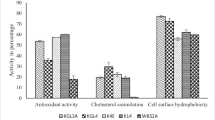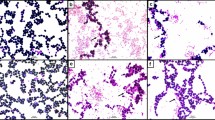Abstract
Potential probiotic yeast strains isolated from fermented food need to meet safe and beneficial conditions for the host’s health. The Pichia kudriavzevii YGM091 strain isolated from fermented goat milk has outstanding probiotic characteristics, including: the high survival percentage in digestive system conditions (reaching up 247.13 ± 0.12 and 145.03 ± 0.06% at pH 3.0 and bile salt 0.5%, respectively); good tolerance to temperature, salt, phenol, ethanol; good surface properties such as high hydrophobicity percentage (> 60%), the high auto-aggregation percentage rate (66.56 ± 1.45% after 45 min of incubation) and the high co-aggregation percentage rate with pathogenic bacteria in a short time (> 40% after 2 h of incubation); biofilm forming after 24 h of incubation on abiotic surfaces; antioxidant activity reached excellent level after only 24 h of incubation (The percentage free radical scavenging and the Trolox equivalent reaching up 79.86 ± 0.70% and 92.09 ± 0.75 µg/mL after 72 h of incubation); extracellular enzymes production protease and cellulase with high activity, amylase and pectinase with moderate activity and non-lipase activity. Simultaneously, the YGM091 strain is the in vitro safety yeast: insensitive to antibiotics and fluconazole, negative for gelatinase, phospholipase, coagulase, and non-hemolysis activities. Furthermore, this strain is in vivo safety yeast with the dosages below 106 CFU/larva in the Galleria mellonella model with over 90% survival larvae and the yeast density reduced to just 102–103 CFU/larva after 72 h post-injection. Research results have demonstrated that the Pichia kudriavzevii YGM091 strain is a safe potential probiotic yeast and could become a candidate probiotic food to be used in the future.




Similar content being viewed by others
References
da Silva LA, Lopes Neto JHP, Cardarelli HR (2019) Safety and probiotic functionality of isolated goat milk lactic acid bacteria. Ann Microbiol 69:1497–1505. https://doi.org/10.1007/s13213-019-01533-z
Syrokou MK, Tziompra S, Psychogiou E-E, Mpisti S-D, Paramithiotis S, Bosnea L, Mataragas M, Skandamis PN, Drosinos EH (2021) Technological and safety attributes of lactic acid bacteria and yeasts isolated from spontaneously fermented Greek wheat sourdoughs. Microorganisms 9(4):671. https://doi.org/10.3390/microorganisms9040671
Ogunremi O, Sanni A, Agrawal R (2015) Probiotic potentials of yeasts isolated from some cereal-based Nigerian traditional fermented food products. J Appl Microbiol 119(3):797–808. https://doi.org/10.1111/jam.12875
Bonatsou S, Karamouza M, Zoumpopoulou G, Mavrogonatou E, Kletsas D, Papadimitriou K, Tsakalidou E, Nychas G-JE, Panagou EΖ (2018) Evaluating the probiotic potential and technological characteristics of yeasts implicated in cv. Kalamata natural black olive fermentation. Int J Food Microbiol 271:48–59. https://doi.org/10.1016/j.ijfoodmicro.2018.02.018
Shen Y, Bai X, Zhang Y, Gao Q, Bu X, Xu Y, Guo N (2022) Evaluation of the potential probiotic yeast characteristics with anti-MRSA abilities. Probiotics Antimicrob Proteins 1–14. https://doi.org/10.1007/s12602-022-09942-4
Lata P, Kumari R, Sharma KB, Rangra S (2022) In vitro evaluation of probiotic potential and enzymatic profiling of Pichia kudriavzevii Y33 isolated from traditional home-made mango pickle. J Genet Eng Biotechnol 20(1):132. https://doi.org/10.1186/s43141-022-00416-2
Goktas H, Dertli E, Sagdic O (2021) Comparison of functional characteristics of distinct Saccharomyces boulardii strains isolated from commercial food supplements. LWT 136:110340. https://doi.org/10.1016/j.lwt.2020.110340
Wulan R, Astuti RI, Rukayadi Y, Meryandini A (2021) Evaluation of Indigenous Pichia kudriavzevii from cocoa fermentation for a probiotic candidate. Biodiversitas Journal of Biological Diversity 22(3):1317–1325. https://doi.org/10.13057/biodiv/d220331
Simões LA, Cristina De Souza A, Ferreira I, Melo DS, Lopes LA, Magnani M, Schwan RF, Dias DR (2021) Probiotic properties of yeasts isolated from Brazilian fermented table olives. J Appl Microbiol 131(4):1983–1997. https://doi.org/10.1111/jam.15065
Fernández-Pacheco P, Ramos Monge IM, Fernández-González M, Poveda Colado JM, Arévalo-Villena M (2021) Safety evaluation of yeasts with probiotic potential. Front Nuth 8:659328. https://doi.org/10.3389/fnut.2021.659328
Romero-Luna HE, Hernández-Sánchez H, Ribas-Aparicio RM, Cauich-Sánchez PI, Dávila-Ortiz G (2019) Evaluation of the probiotic potential of Saccharomyces cerevisiae Strain (C41) isolated from Tibicos by in vitro studies. Probiotics Antimicrob Proteins 11(3):794–800. https://doi.org/10.1007/s12602-018-9471-2
Lara-Hidalgo C, Dorantes-Álvarez L, Hernández-Sánchez H, Santoyo-Tepole F, Martínez-Torres A, Villa-Tanaca L, Hernández-Rodríguez C (2019) Isolation of yeasts from Guajillo pepper (Capsicum annuum L.) fermentation and study of some probiotic characteristics. Probiotics Antimicrob 11(3):748–764. https://doi.org/10.1007/s12602-018-9415-x
Baccouri O, Boukerb AM, Farhat LB, Zébré A, Zimmermann K, Domann E, Cambronel M, Barreau M, Maillot O, Rincé I (2019) Probiotic potential and safety evaluation of Enterococcus faecalis OB14 and OB15, isolated from traditional tunisian testouri cheese and rigouta, using physiological and genomic analysis. Front Microbiol 10:881. https://doi.org/10.3389/fmicb.2019.00881
Gilliland SE, Morelli L, Reid G (2006) Probiotics in food: health and nutritional properties and guidelines for evaluation. FAO/WHO, Rome. http://www.who.int/foodsafety/fsmanagement/en/probioticguidelines.pdf
Elhalis H, Cox J, Frank D, Zhao J (2021) Microbiological and biochemical performances of six yeast species as potential starter cultures for wet fermentation of coffee beans. LWT 137:110430. https://doi.org/10.1016/j.lwt.2020.110430
Fu J, Liu J, Wen X, Zhang G, Cai J, Qiao Z, An Z, Zheng J, Li L (2022) Unique probiotic properties and bioactive metabolites of Saccharomyces boulardii. Probiotics Antimicrob 1–16. https://doi.org/10.1007/s12602-022-09953-1
Menezes AGT, Ramos CL, Cenzi G, Melo DS, Dias DR, Schwan RF (2020) Probiotic potential, antioxidant activity, and phytase production of indigenous yeasts isolated from indigenous fermented foods. Probiotics Antimicrob 12(1):280–288. https://doi.org/10.1007/s12602-019-9518-z
Wang J, Da R, Tuo X, Cheng Y, Wei J, Jiang K, Lv J, Adediji OM, Han B (2020) Probiotic and safety properties screening of Enterococcus faecalis from healthy Chinese infants. Probiotics Antimicrob 12:1115–1125. https://doi.org/10.1007/s12602-019-09625-7
Pongcharoen P (2022) The ability of Pichia kudriavzevii to tolerate multiple stresses makes it promising for develo** improved bioethanol production processes. Lett Appl Microbiol 75:36–44. https://doi.org/10.1111/lam.13703
Mladenović KG, Grujović MŽ, D Nikodijević D, Čomić LR (2020) The hydrophobicity of enterobacteria and their co-aggregation with Enterococcus faecalis isolated from Serbian cheese. Biosci Microbiota Food Health 39(4):227–233. https://doi.org/10.12938/bmfh.2020-004
Naimah AK, Al-Manhel AJA, Al-Shawi MJ (2018) Isolation, purification and characterization of antimicrobial peptides produced from Saccharomyces boulardii. Int J Pept 24:455–461. https://doi.org/10.1007/s10989-017-9632-2
Al-Sahlany STG, Altemimi AB, Abd Al-Manhel AJ, Niamah AK, Lakhssassi N, Ibrahim SA (2020) Purification of bioactive peptide with antimicrobial properties produced by Saccharomyces cerevisiae. Foods 9(3). https://doi.org/10.3390/foods9030324
Alonso-Monge R, Prieto D, Coman I, Rochas S, Arana DM, Hidalgo-Vico S, Román E, Pla J (2021) Identification of clinical isolates of Candida albicans with increased fitness in colonization of the murine gut. J Fungus 7(9):695. https://doi.org/10.3390/jof7090695
Cutuli MA, Petronio Petronio G, Vergalito F, Magnifico I, Pietrangelo L, Venditti N, Di Marco R (2019) Galleria mellonella as a consolidated in vivo model hosts: new developments in antibacterial strategies and novel drug testing. Virulence 10(1):527–541. https://doi.org/10.1080/21505594.2019.1621649
Jorjao AL, Oliveira LD, Scorzoni L, Figueiredo-Godoi LMA, Cristina A, Prata M, Jorge AOC, Junqueira JC (2018) From moths to caterpillars: ideal conditions for Galleria mellonella rearing for in vivo microbiological studies. Virulence 9(1):383–389. https://doi.org/10.1080/21505594.2017.1397871
Pereira MF, Rossi CC (2020) Overview of rearing and testing conditions and a guide for optimizing Galleria mellonella breeding and use in the laboratory for scientific purposes. APMIS 128(12):607–620. https://doi.org/10.1111/apm.13082
Peréz-Través L, De Llanos R, Flockhart A, García-Domingo L, Groenewald M, Pérez-Torrado R, Querol A (2021) Virulence related traits in yeast species associated with food; Debaryomyces hansenii, Kluyveromyces marxianus, and Wickerhamomyces anomalus. Food Control 124:107901. https://doi.org/10.1016/j.foodcont.2021.107901
Chelliah R, Ramakrishnan SR, Prabhu PR, Antony U (2016) Evaluation of antimicrobial activity and probiotic properties of wild-strain Pichia kudriavzevii isolated from frozen idli batter. Yeast 33(8):385–401. https://doi.org/10.1002/yea.3181
Petropavlovskiy AA, Tauro MG, Lajoie P, Duennwald ML (2020) A quantitative imaging-based protocol for yeast growth and survival on agar plates. STAR Protoc 1(3):100182. https://doi.org/10.1016/j.xpro.2020.100182
Hossain MN, Afrin S, Humayun S, Ahmed MM, Saha BK (2020) Identification and growth characterization of a novel strain of Saccharomyces boulardii isolated from soya paste. Front Nuth 7:27. https://doi.org/10.3389/fnut.2020.00027
Mehta D, Metzger L, Hassan A, Nelson B, Patel H (2019) The ability of spore formers to degrade milk proteins, fat, phospholipids, common stabilizers, and exopolysaccharides. J Dairy Sci 102(12):10799–10813. https://doi.org/10.3168/jds.2019-16623
Wayne P (2009) Zone diameter interpretive standards, corresponding minimal inhibitory concentration (MIC) interpretive breakpoints, and quality control limits for antifungal disk diffusion susceptibility testing of yeasts. Third International Supplement CLSI document-M444-S3, New York, US
Alkalbani NS, Osaili TM, Al-Nabulsi AA, Olaimat AN, Liu S-Q, Shah NP, Apostolopoulos V, Ayyash MM (2022) Assessment of yeasts as potential probiotics: a review of gastrointestinal tract conditions and investigation methods. J Fungus 8(4):365. https://doi.org/10.3390/jof8040365
Kim-Diep T, Hoai-Hieu V, Thanh-Vy DT, Kim-Thoa NH, Hong-Hoang N, Tuyet-Hanh VH, Nha-Hoa P (2022) Assessment of cell surface characteristics of Pichia kudriavzevii YGM091-screening of yeast strains isolated from fermented goat’s milk. Vietnam: Vietnam Biological Association: 1106–1111
Hoai-Hieu V, Tam Nguyen T, Kim-Thoa NH, Huu-Tri T, Duc-Hoa N, Nha-Hoa P, Kim-Diep T (2022) Morphology and biology characterization of some yeast strains isolated from naturally fermented goat milk in Dak Lak province. Proceeding of the 5th National scientific conference on Biological research and teaching in Vietnam: 191–198
Acknowledgements
We are grateful to the Tay Nguyen Institute of Scientific Research, the Vietnam Academy of Science and Technology, and the Experiment Center-Practice, Yersin University for supporting this study.
Author information
Authors and Affiliations
Contributions
Kim-Diep Tran: designed the study, and wrote the first and final version of the article. Loan Le-Thi and Hoai-Hieu Vo: designed this part of the experiments, supported the study with microorganism strains and the invertebrate model, and reviewed the different versions of the manuscript. Thanh-Vy Dinh-Thi: designed this part of the experiments, supported the study with microorganism strains and the invertebrate model, and analyzed the data. Tam Nguyen-Thi: supported the study with microorganism strains. Nha-Hoa Phan: supported the study with yeast strains. Khanh-Uyen Nguyen: supported the study with the invertebrate model. All authors performed the experiments, read critically, and approved the manuscript.
Corresponding author
Ethics declarations
Conflict of Interest
The authors declare no competing interests.
Additional information
Publisher's Note
Springer Nature remains neutral with regard to jurisdictional claims in published maps and institutional affiliations.
Rights and permissions
Springer Nature or its licensor (e.g. a society or other partner) holds exclusive rights to this article under a publishing agreement with the author(s) or other rightsholder(s); author self-archiving of the accepted manuscript version of this article is solely governed by the terms of such publishing agreement and applicable law.
About this article
Cite this article
Tran, KD., Le-Thi, L., Vo, HH. et al. Probiotic Properties and Safety Evaluation in the Invertebrate Model Host Galleria mellonella of the Pichia kudriavzevii YGM091 Strain Isolated from Fermented Goat Milk. Probiotics & Antimicro. Prot. (2023). https://doi.org/10.1007/s12602-023-10114-1
Accepted:
Published:
DOI: https://doi.org/10.1007/s12602-023-10114-1




